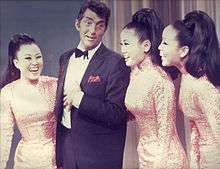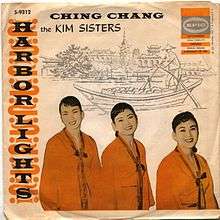The Kim Sisters
| The Kim Sisters | |
|---|---|
 The Kim Sisters with Dean Martin. | |
| Background information | |
| Origin | South Korea |
| Genres | Pop |
| Occupation(s) | Singers |
| Years active | 1950s-1980s |
| Past members |
|
The Kim Sisters were a Korean-born American singing trio who made their career in the United States during the 1950s and 1960s. They are known for being the first South Korean music group to achieve success in the U.S. market, and for performing more than 20 times on The Ed Sullivan Show. The group consisted of Sue, Aija and Mia. [1][2]
Early lives
Sue and Aija's parents were Kim Hae-song, a popular conductor, and Lee Nan-young, one of Korea's most famous singers before the Korean War, best known for her song, "Tears of Mokpo." Mia's father was Lee Bong-ryong, a musician and Lee Nan-young's elder brother.[3]
In 1950, North Korea captured and later executed Sue and Aija's father, Kim Hae-song.[4]
Career
Beginnings
Following her husband's kidnapping, Lee Nan-young adopted Mia and had her daughters form a singing group in order to support the family. [4] Lee bought American records on the black market so that the girls could learn songs like Hoagy Carmichael's "Ole Buttermilk Sky," which they performed in bars and nightclubs for American soldiers stationed in South Korea during the Korean War.[5]

The Kim Sisters were popular among the American troops, who spread the word about the group to American entertainment producer Tom Ball. He flew to South Korean in 1958 to hear the group perform, and The Kim Sisters signed a contract with Ball soon after. However, it took them nearly a year to acquire visas to go to the United States.[5]
Fame in the United States
In 1959, The Kim Sisters arrived in Las Vegas to perform in Ball's "China Doll Revue" at the Thunderbird Hotel.[4] After they fulfilled their contract at the Thunderbird, The Kim Sisters began performing at the Stardust Hotel. It was during this time that they were first invited to perform on The Ed Sullivan Show. They ultimately performed on the show an additional 21 times.[6] On American television shows, The Kim Sisters frequently performed wearing Chinese cheongsam and singing popular American songs.[4]
In 1962, their cover of The Coasters song "Charlie Brown" reached #7 on the Billboard singles chart, making The Kim Sisters the first commercially successful Asian artists in the United States.[7]
Aija died of lung cancer in 1987.[2][5] Mia still actively performs.[8]
Discography
Studio albums
| Title | Album details[9] |
|---|---|
| Their First Album |
|
| 푸레젠트 |
|
| 어머니를 추모한 김시스터즈 가요집 |
|
| This Is My Life |
|
U.S. single albums
| Title | Album details[10] |
|---|---|
| A: "Harbor Lights"
B: "Ching Chang" |
|
| A: "A Diamond is Forever"
B: "Now Is The Hour" |
|
| A: "Love Star"
B: "You Can't Have Everything (They Say)" |
|
| A: "Blueberry Pie"
B: "We're Going Back Together" |
|
| A: "Mister Magic Moon"
B: "Roses in the Snow" |
|
| A: "Charlie Brown"
B: "Korean Spring Song" |
|
| A: "Bittersweet"
B: "Tic-A-Tic-A-Toc-Toc" |
|
| A: "No Sad Songs For Me"
B: "Just Like Taking Candy From A Baby" |
|
References
- ↑ Song, Cheol-min (2016). K-pop Beyond Asia. Korean Culture and Information Service. pp. 23–24. ISBN 978-8973755981.
- 1 2 Teszar, David (2011-09-21). "From Seoul to Las Vegas: story of the Kim Sisters". The Korea Times. Retrieved 2018-01-19.
- ↑ Yim, Seung-hee (2017-01-31). "The Kim Sisters, pioneering K-pop stars, recall their journey : New documentary "Try to Remember" tells the story of the trio who dominated Vegas Strip". Korea JoongAng Daily. Retrieved 2018-01-19.
- 1 2 3 4 Seid, Danielle (2016). "Forgotten Femmes, Forgotten War: The Kim Sisters' Disappearance from American Screen and Scene". Occasional Paper Series (Las Vegas: Center for Gaming Research) (38). Retrieved 2018-01-18.
- 1 2 3 Hong, Euny (2014). The Birth of Korean Cool: How One Nation Is Conquering the World Through Pop Culture. Simon and Schuster. ISBN 978-1471131059.
- ↑ I-Fen Cheng, Cindy, ed. (2016). The Routledge Handbook of Asian American Studies. Routledge. ISBN 978-1317813910.
- ↑ "Girl Groups in Korean Pop Music History". KBS World Radio. 2012-05-29. Retrieved 2018-01-19.
- ↑ Upcoming Performances at Mia’s web site
- ↑ "The Kim Sisters". Discogs. Retrieved 2018-01-19.
- ↑ "The Kim Sisters Discography - USA". 45cat. Retrieved 2018-01-19.
External links
| Wikimedia Commons has media related to The Kim Sisters. |